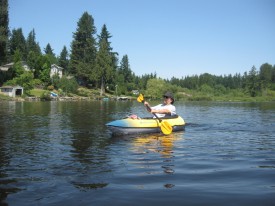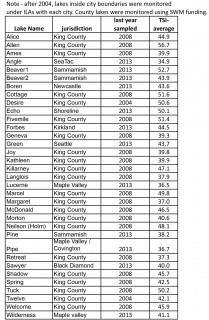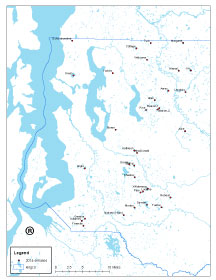by Sally Abella and Rachael Gravon
 The largest lakes in King County, including Washington, Sammamish, and Union, have been monitored for water quality for many years as their watersheds have been developed and sewage systems installed and updated, while area population has grown tremendously. However, King County also has many smaller lakes across the landscape, a legacy of the last large glaciation more than 10,000 years ago. Many of the lowland lakes have interesting histories, whether they were used as logging mill ponds, served as summer resorts for city dwellers, or, more recently, as focal points for residential development on the urban fringes. Quite a few have public boat launches managed by the Washington Department of Fish and Wildlife (WDFW). These lakes have open seasons for fishing, and most are stocked annually with rainbow trout by WDFW for public recreation. Some lakes also have parks, trails, and beaches. In addition to the recreational benefits they offer, these small lakes have small watersheds that reflect local conditions and can provide early warning of environmental change.
The largest lakes in King County, including Washington, Sammamish, and Union, have been monitored for water quality for many years as their watersheds have been developed and sewage systems installed and updated, while area population has grown tremendously. However, King County also has many smaller lakes across the landscape, a legacy of the last large glaciation more than 10,000 years ago. Many of the lowland lakes have interesting histories, whether they were used as logging mill ponds, served as summer resorts for city dwellers, or, more recently, as focal points for residential development on the urban fringes. Quite a few have public boat launches managed by the Washington Department of Fish and Wildlife (WDFW). These lakes have open seasons for fishing, and most are stocked annually with rainbow trout by WDFW for public recreation. Some lakes also have parks, trails, and beaches. In addition to the recreational benefits they offer, these small lakes have small watersheds that reflect local conditions and can provide early warning of environmental change.
The Lake Stewardship program began in 1994, combining two volunteer-based water quality programs for small lakes that had been managed by King County and METRO before the two agencies merged. As many as 55 county lakes were monitored between 1994 and 2004 with help from interested citizens. Unfortunately, budgetary constraints in 2005 brought a decrease in monitored lakes, and 2009 brought additional cuts. Twelve lake communities were able to continue sampling with funding help from nearby cities. In 2014, restored county funding allowed staff to add 22 lakes back into the program, making a total of 34 lakes that were tracked this year (Figure 1).
Choosing just 22 lakes was a challenge because they all have interesting or unique characteristics. Factors considered included lake location, history of changes in algae or nutrients, importance of the lake for water storage or stormwater pathways, public accessibility, or similarity to other lakes found across the county.
When previous volunteers were contacted to see if they wanted to resume monitoring work, their response was immediate and heartening: a roster of more than 100 citizens was compiled in just a few weeks. In late March of 2014, more than 60 people came to a volunteer training workshop at the Preston Community Center. Lake volunteers, friends, and family members received training in water sampling and listened to presentations about water quality, aquatic plant life, and algal blooms.
Collaborating with trained volunteers benefits everyone. Reducing labor costs makes it possible to monitor many more lakes than could otherwise be tracked, thus providing a more accurate regional picture of lake health. Even more important, training residents increases the number of eyes on a lake, so significant changes can be detected rapidly. Additionally, the program allows King County residents to be directly involved in work done by the Sciences and Technical Support Section. Volunteers learn about water quality and watershed management and provide effective outreach to other interested citizens.
Volunteers may participate in daily, weekly, or summer bi-weekly (May-October) monitoring programs. In addition to water quality, volunteers track recreational use and monitor potential nuisances, such as geese. They also report algal accumulations that could signal a health and safety threat, such as a toxic algae bloom.
Water quality data from the summer program is uploaded onto the King County Small Lakes Information and Data Page (link below). This page provides physical information about the lakes, maps, water quality reports, and gives visitors the option of downloading or viewing water quality data. Staff hope to prepare an annual summary of the lakes data so interested people can look at the values in a regional context, as well as compare among the lakes. For those lakes with enough data for statistical significance, trends will also be evaluated.
To visit the King County Small Lakes Information and Data Page, go to http://green2.kingcounty.gov/SmallLakes/WQData.aspx.
For more information about the Lake Stewardship Program, please visit http://www.kingcounty.gov/environment/wlr/sections-programs/science-section/lake-stewardship-program.aspx.
With any other questions about King County’s small lakes or lake monitoring, contact Sally Abella at sally.abella@kingcounty.gov or Rachael Gravon at rachael.gravon@kingcounty.gov











